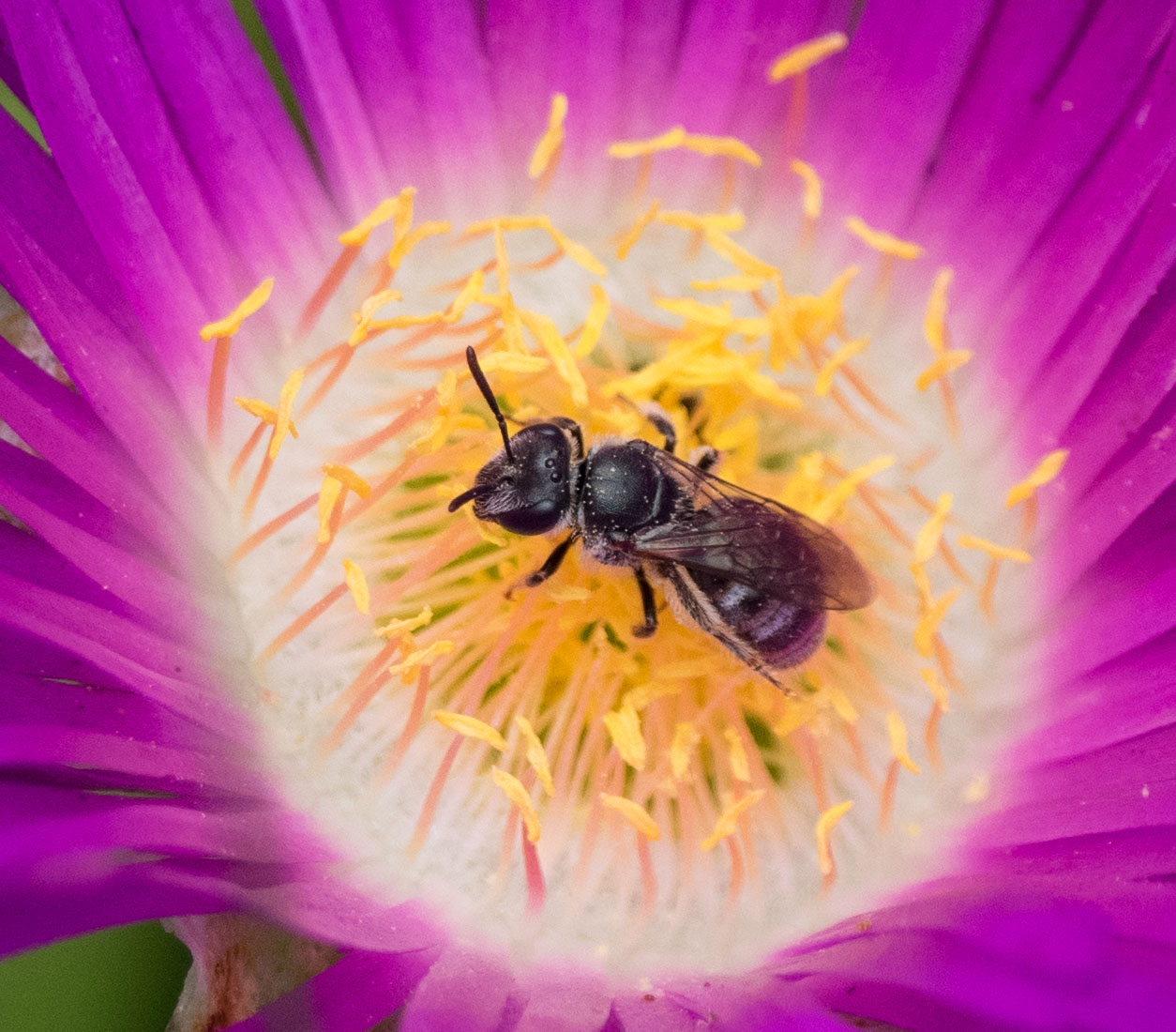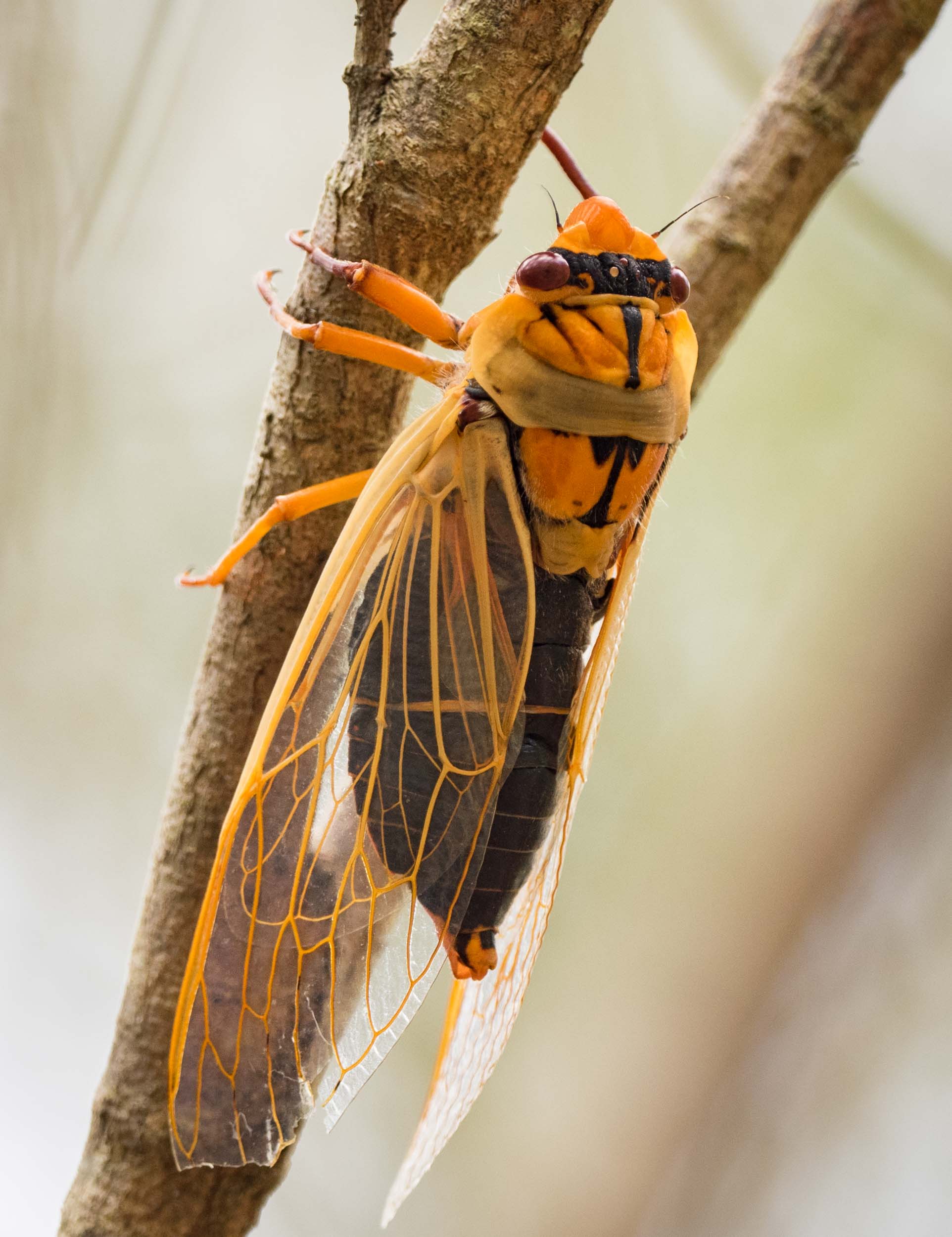
stick insect nymph
This is a nymphal stage of a stick insect - probably either Podocanthus typhon or Ctenomorpha marginipennis. Hard to tell till it grows up.

stick insect nymph
These amiable animals feed on vegetation of a variety of plant species

Tiger Orchid
In the last week we've sighted the first Tiger Orchids (Diuris sulphurea) of the season. These ones were gone the next day - swamp wallabies love them!

Flying Duck Orchid
We sighted dozens of these plants on an orchid hunt in Nadgee Nature Reserve a month ago. At that stage the flowers had not yet opened. We returned to the spot with friends a couple of days ago and were delighted to find many of the plants in full flower.

Green Long-legged Fly
The zucchini and pumpkin seedlings in our vegetable garden have now grown decent sized leaves. And as happens every year a couple of species of small, colourful flies have taken up positions on these leaves - I presume to stake out mating territory. This is one of them - Parentia vulgaris.

Long-legged fly
This is another species of these long-legged flies. I haven't been able to identify it yet, but it certainly belongs to the family Dolichopodidae. A long family name for a rather small fly - 2-3mm long.

Long-legged fly
Pretty elegant beasts, I think. This and the previous species are predators. They catch and eat even smaller insects.

Paper Wasp
The very earliest stages of nest construction and colony establishment – just one of several such developments underway at our friends' nearby property.

Pied Oystercatcher
Beach-nesting shorebirds often wear identifying flags, as part of long-term study and conservation programs. H5 is well-known to us. Wonboyn Beach, NSW.

Pied Oystercatcher
It's worms, not oysters, that these birds are usually pulling from the beach sands. H5 was banded near Melbourne in 2007 and is now at least 14 years old! Wonboyn Beach, NSW.

Blue Ringtail
Austrolestes annulosus, numerous at a beachside lagoon about an hour's drive to our north. Bournda National Park, NSW

It's called the 'wheel' ...
... but looks like a heart! Blue Ringtail damselflies demonstrating the classical Odonata mating position. Bournda National Park, NSW

Common Dolphin
We watched a pod of Short-beaked Common Dolphins surfing alongside the boat during a wonderful whale-watching cruise yesterday. Eden coast, NSW.

Australasian Gannet
One of the more common seabirds of the nearby coastal waters – this one briefly cruising alongside the whale-watching boat, backlit by the early morning sun. Eden coast, NSW.

Baby Humpback at play
By the time they reach our coast on their first journey to Antarctic waters, this years' youngsters are about three months old - and very active! Eden coast, NSW.

tiny metallic green fly
Most of the photos this week were taken during a quick trip to southern Victoria and the Australian Alps. This as-yet unidentified fly was displaying on a fallen leaf in the Gurdies Conservation Area, Victoria

Knobbled Orb-weaver
This is probably Eriophora pustulosa, although it's difficult to be sure - the genus is widespread, highly variable, and under revision.
The Gurdies Nature Conservation Reserve, Victoria

Yellow-faced Honeyeater
These vocal birds are regular visitors to the southern forests, including throughout south-eastern Victoria.
The Gurdies Nature Conservation Reserve, Victoria

White-naped Honeyeater
A bossy little species, commonly seen flying and feeding alongside Yellow-faced Honeyeaters.
The Gurdies Nature Conservation Reserve, Victoria

More bees
I initially thought this was a wasp, but I'm now convinced it's a bee. Species? I'm working on it.
The Gurdies Nature Conservation Reserve, Victoria

'Bubbling' bee
Many native bee species have been reported, and photographed, 'bubbling'. They regurgitate a bead of nectar, presumably as a way of making it more concentrated by evaporation.
The Gurdies Nature Conservation Reserve, Victoria

Flame Robin
The high country is the best place to see Flame Robins. The extraordinary colour of the male makes them difficult to overlook, even in an Alpine forest.
Kosciuszko National Park

Flame Robin
Kosciuszko National Park

Flame Robin
This male Flame Robin spent some time beating a caterpillar against a branch, before swallowing it. Guess he doesn't like his meals to wriggle on the way down.
Kosciuszko National Park

Striated Pardalotes
The calls of breeding pardalotes rung out in the forest lining the banks of Thredbo River.
Kosciuszko National Park

Striated Pardalote
Peering from a nest hollow.
Kosciuszko National Park

Striated Pardalote
Kosciuszko National Park

More bees
My obsession with bees continues.
Kosciuszko National Park

Another tiny bee
Yesterday I discovered that the Carpobrotus ('Pigface') flowers at the beach are full of tiny native bees.
Wonboyn Lake, NSW

Another tiny bee
These tiny bees completely disappear among the stamens, no doubt diving down to the where the nectar is pooling.
Wonboyn Lake, NSW

Sacred Kingfisher
Most of the photos this week were taken on our travels in Victoria and the Australian Alps. This one, however, is one of our home birds. The pair is now well-settled and they almost certainly have eggs.

Wombat Berry
This pretty vine has finally flowered! We've been waiting for a couple of years, unable to confirm the identity - until now.
Eustrephus latifolius (Wombat Berry)

Wombat Berry
The species is typically found in rainforest, so our single plant is a little out of its comfort zone. I guess a bird planted it after feeding on the berries.
Eustrephus latifolius (Wombat Berry)

Huge longhorn beetle
This massive and impressive beetle was hard to ignore when it crash landed among the grasses.
Order: Coleoptera; Family: Cerambycidae

Masked Devil
The number of cicadas currently calling from the treetops is huge - and so is the noise! We have both orange and green forms here, many of them with extensive black markings.
Cyclochila australasiae

Tiny moth
This tiny, snowy moth with the extraordinary hairdo caught my attention as it rested on a leaf. The larvae feed on rushes (Juncus sp.)
Family: Crambidae; Species: Tipanaea patulella

Small-headed Fly
These weird-looking flies parasitise spiders. We've seen the adults rarely, and only in November.
Family: Acroceridae; Species: Ogcodes basalis(?)

Ichneumonid wasp
Many species of solitary and slender wasps in the warning colours of orange and black are busily flitting about in search of host insects into which to insert their eggs.

Bee Fly
An interesting approach to flower feeding - keep flying, and reach.
Order: Diptera; Family: Bombyliidae; Genus: Staurostichus

Weevil
An alternative approach to flower feeding - dive right in.
Order: Coleoptera; Family: Curculionidae

Masked Bee
My fascination with native bees continues:
The Leptospermum continentale flowers are attracting numerous tiny bees with yellow spots. I'm thinking these are Masked Bees - Family Colletidae, subfamily Hylaeniae. I think.

Another tiny bee
So small that at first I thought this was an ant. Identity remains a work in progress

Bees love Dianella
If you want to see native bees, check out flowering Dianella. It's a bee magnet!

Fringe Lily ... with bee!
Now that I'm looking for them, I realise that there are bees everywhere! Well, everywhere that there is nectar and pollen, at least.

NOT a bee
The Sand Wasps that I featured in a post last week also visit flowers. They take a quick sip of nectar and move on, unlike the pollen-gathering bees.
Order: Hymenoptera; Family: Crabrondiae

Imperial Hairstreak
The Leptospermum flowers attract many nectar-feeders, including this Imperial Hairstreak seen egg laying on Acacia just moments before.
Jalmenus evagoras

Crab spider
An ambush predator fully alert, having moments before this photo just missed nabbing a visiting bee.
Red-tipped Crab Spider (Sidymella rubrosignata)

mouse spider
Missulena sp.
Another spider ready to pounce, but this one is a little more intimidating.

Blue Skimmer
A common Summer visitor to the frog pond. This male has taken charge of the territory for a week now, although there are still relatively few competitors about.
Orthetrum caledonicum

Red-bellied Black Snake
After cruising the pond in pursuit of frogs and tadpoles, our now-resident snake rested on the rocks ... whether yawning or swallowing, I'm not sure.

Leucopogon berries
Remember those white Leucopogon flowers that were such a hit with the insects? Well, the ripening berries are now proving even more popular with the birds!
Leucopogon affinis

Tree Martins
A common species, appearing in southern Australia during the Summer breeding season. Several nesting pairs were sharing this large eucalypt on the shores of the Gippsland Lakes.
Metung, Victoria.

Little Pied Cormorant
The smallest of the four species of cormorants common across much of Australia, Little Pieds are usually solitary during the day but may gather to roost at night.
Metung, Victoria

Black Swans
Such a commonplace bird that I rarely bother to photograph them - but when they show their ruffles off like this, and when I'm with a friend from Germany, I look at them anew.
Metung, Victoria

Australian Pied Oystercatchers
The immature bird may be 2-3 years old. The legs and bill gradually deepen in colour, with the brown tip to the bill disappearing at 3-4 years of age.
Metung, Victoria

Long-billed Corella
This sighting was a 'first' for us, and therefore very exciting. Despite being on the lookout for these (common!) birds whenever we've travelled in southern Australia, we hadn't seen them before.
Kyneton, Victoria

At the Lighthouse
Wombats in broad daylight! The area around Greencape Lighthouse must seem a safe haven for the healthy population there.
Greencape, Ben Boyd National Park, NSW

Last of the migrants
With the Humpback migration almost over for another season, we were lucky to see several mothers and calves passing Greencape Lighthouse during our overnight stay there (in mid November).

Bees and peas
I was fascinated to see how this little bee prised open a Gompholobium flower to access the pollen.
Ben Boyd National Park

Bees and Pigface
The gaudy flowers of Carpobrotus glaucescens are packed with pollen and, unsurprisingly, packed with bees of various species.




























































